Introduction
One cannot underestimate the role of financial issues and their influence on the development of businesses (Mitter & Kraus, 2011).
For instance, many entrepreneurs have to take into account the economic fluctuations and changes in the financial markets, as they have a clear impact on the effectiveness of the firm (Mitter & Kraus, 2011).
Considering risks helps the company:
- Budget its finances effectively;
- Minimize the impact of risks on the development and growth of the organization;
- Avoid conflicts with main stakeholders and shareholders of the company;
- And maximize company’s profits.
Nowadays, the functioning of the businesses is dependent on various factors. In this case, one cannot underestimate the role of financial issues and their influence on the development of businesses (Mitter & Kraus, 2011). For instance, many entrepreneurs have to take into account the economic fluctuations and changes in the financial markets, as they have a clear impact on the effectiveness of the firm (Mitter & Kraus, 2011). It helps the management of the company budget its finances effectively, minimize the impact of risks on the development and growth of the organization, avoid conflicts with main stakeholders and shareholders of the company, and maximize company’s profits.
As for the medical sphere, it remains apparent that this business segment is highly competitive. Consequently, one cannot underestimate the fact that hospitals and other business institutions will need to consider the similar risks, which are mentioned above.

Goals of the Paper
- Discuss various issues and their effect on the functioning of the medical institutions and hospitals;
- Identify the major emerging risks;
- Determine their influence on reimbursement and healthcare delivery models;
- Analyze the emerging risks and compliance issues;
- Predicting mitigation schemes;
- Determine the changes caused by these matters in the nursing career while considering new tendencies in leadership and change management;
- Draw conclusions and recommendation.
Based on the factors and aspects depicted in the previous slide, it could be said that it is critical to discuss various issues and their effect on the functioning of the medical institutions and hospitals. In the first place, it will be essential to identify the major emerging risks, as they have a clear impact on the functioning of the hospitals and their financial prosperity. To underline the powerful nature of risks, it will be necessary to determine their influence on reimbursement and healthcare delivery models. At the same time, it is critical to analyze the emerging risks and compliance issues. Alternatively, predicting mitigation schemes will have a beneficial impact on the quality of the services and the effectiveness of decision-making within the organization. Alternatively, it is vital to determine the changes caused by these matters in the nursing career while considering new tendencies in leadership and change management. In the end, the conclusions and recommendations are drawn to summarize the main findings of the presentation.

Financial Issues and Changes in Reimbursement and Care Delivery Models
- The ACA attempted to offer the universal coverage to the citizens of the United States of America (Blumenthal, Stremikis, & Cutler, 2013).
- Its intentions were successful, as it decreased the percentage of uninsured people (Blumenthal et al., 2013).
- However, it led to the increase in the operational costs.
- Other Issues:
- Ineffective budgeting,
- Geographical disparities,
- The lack of knowledge of financial systems and budget alignment,
- The inability to consider emerging risks;
- And the need to optimize the ACA reform.
- Training:
- The quality of the provided healthcare defines the desire of the patients to continue a relationship with the medical institution (Bowman, 2013).
- Technological Improvement:
- To maintain competitive in the market, it is necessary to invest in new equipment and systems such as Electronic Health Care Records (EHR) (Bowman, 2013).
- The Associated Financial Issues: Expensive and complicated to maintain.
- Effect on Reimbursement System:
- The ACA increases the insurance coverage and includes different segment of population such as seniors and youngsters causes the changes in the models (Beveridge, Happe, & Funk, 2016).
Fee-based model → Value-based model.
- Care Delivery Models:
- ´The rising popularity of the patient-centered care approach can be explained by the value-based payment system.
- ´The physicians and nurses have to focus on the satisfaction of the customers, as they are the main components of the system (Constand, MacDermid, Bello-Haas, & Law, 2014).
- ´It helps maximize the revenues and boost satisfaction.
Satisfaction of the Patients + Considering Patient’s Needs and Preferences → Patient-Centered Care
In the first place, it is critical to identify the major financial issues that have an effect on the quality of the provided services and healthcare models. In this case, it is critical to focus on the ACA reform, as it aimed to offer the universal insurance to the citizens of the United States of America (Blumenthal, Stremikis, & Cutler, 2013). It could be said that its intentions were successful, as it decreased the percentage of uninsured people (Blumenthal et al., 2013). Increasing the coverage of the number of individuals eligible for the Medicaid insurance increase the operational costs (Blumenthal et al., 2013). It leads to the need to reconsider budgeting of the healthcare institutions across the country. The slide also displays other associated issues.
Despite the significance of the previous sections, it is vital to discuss the ways that these financial issues affect the reimbursement. In this case, the fact that the ACA increases the insurance coverage and includes different segments of population such as seniors and youngsters causes the changes in the models (Beveridge, Happe, & Funk, 2016). Now, the value-based model is being prioritized (Beveridge et al., 2016). In this case, the payment to physicians and nurses is dependent not on a number of the patients and hours per day but on the quality performance indicators.
At the same time, it remains apparent that one cannot underestimate the fact that the financial issues indicated in the previous sections have a tendency to affect the care delivery models. In this case, the rising popularity of the patient-centered care approach can be explained by the value-based payment system. This matter is vehemently important to consider since it has a critical impact on the healthcare delivery models and financial prosperity of medical institutions. In this case, the physicians and nurses have to focus on the satisfaction of the customers, as they are the main components of the system (Constand, MacDermid, Bello-Haas, & Law, 2014). It helps maximize the revenues and boost satisfaction.
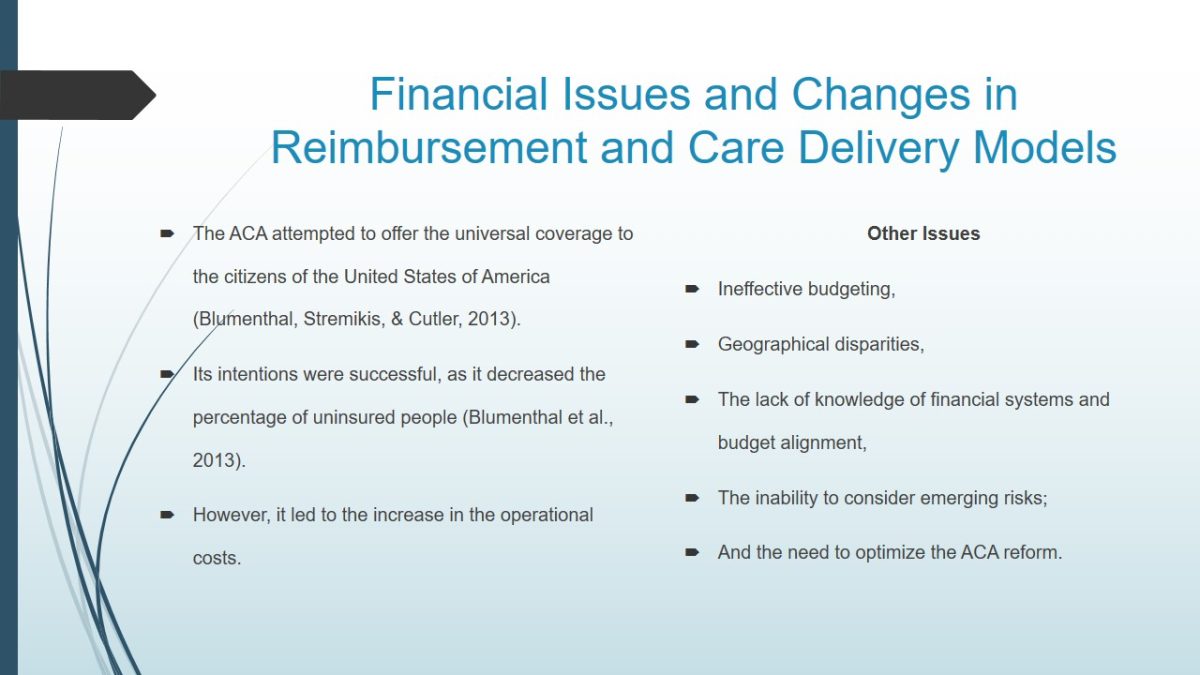


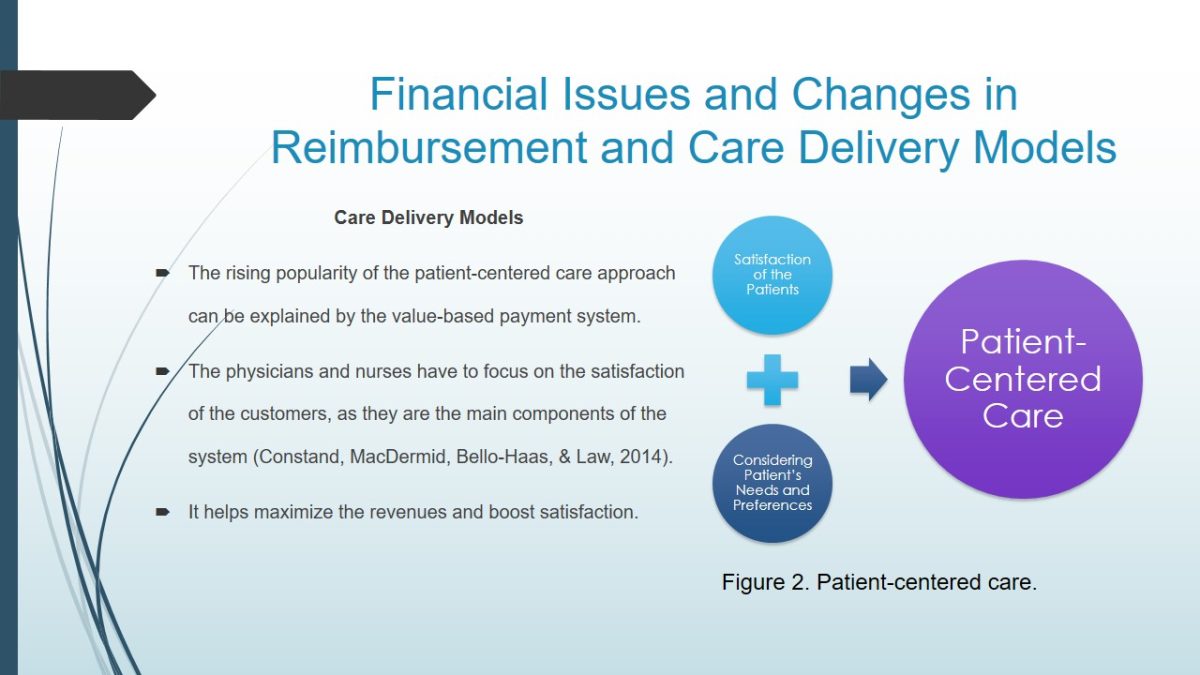
Emerging Risks, Compliance Issues, and Mitigation Schemes
- Emerging Financial Risks:
- The need to reconsider the states of expenditure to comply with the industry standards;
- Additional investment in the development of the technology and training;
- The innovation of the ACA requirements to enlarge the Medicaid insurance coverage (Beveridge et al., 2016);
- Economic and political instability of the country.
- Emerging Risks:
- Rising privacy concerns;
- The need to optimize electronic healthcare systems (Mohammed, Mariani, & Mohammed, 2015);
- Continuous development of technology;
- Changes in consumer preferences;
- The necessity to increase the workload and training of the medical personnel to meet the budgeting requirements and offer high-quality care to the individuals in need (Constand et al., 2014).
- Compliance Issues:
- Meeting changes in the Medicare policies and the ACA regulations;
- Complying with the revised EHR standards;
- Ensuring the security of the data collected from the patients (Mohammed et al., 2015).
- Conclusion:
- These aspects are critical since these matters have to be provisioned when developing a budget to avoid significant variances in costs, as they can lead to the loss of the revenue.
- Mitigation Schemes: Minimizing General Risks:
- Conducting the analysis of the industry standards and the emerging trends;
- Monitoring the changes in the actions of the competitors;
- Considering the modifications in the preferences of different stakeholder groups;
- Evaluating the significance of proposed risks and trends;
- Aligning the company’s strategies with the aspects identified above to minimize risks and stay competitive.
- Mitigation Scheme: Minimizing Financial Risks:
- Listing all the risks and evaluating their impact on the financial prosperity of the hospital;
- Analyzing the level of impact of the indicated risks on the budgeting initiatives by measuring potential cost variances and conducting ratio analysis;
- Establishing a risk mitigation plan to ensure the alignment of the existent budgeting plan with its revised version;
- Assessing whether the proposed policies improved the quality of the delivered services and minimized the possibility of the occurred risks.
- Reviewing the states of expenditure and the sources of revenue to optimize its financial effectiveness.
At the same time, it is critical to consider different risks that may take place in the healthcare sphere in the recent future. In this case, the main financial risks are associated with the need to reconsider the states of expenditure to comply with the industry standards, additional investment in the development of the technology and training, changes in economic and political stability, and the innovation of the ACA requirements to enlarge the Medicaid insurance coverage (Beveridge et al., 2016). A combination of these factors will have a beneficial impact on the provisioning of the budget and assist in optimizing the states of expenditure.
Apart from the major emerging financial risks, it is critical to consider various rising trends in the healthcare segment, as they may require increasing the expenditure. For instance, the main risks are related to rising privacy concerns and the need to optimize electronic healthcare systems (Mohammed, Mariani, & Mohammed, 2015). At the same time, it is critical to pay vehement attention to the continuous development of technology and the necessity to increase the workload and training of the medical personnel to meet the budgeting requirements and offer high-quality care to the individuals in need (Constand et al., 2014). In this case, these matters will require additional expenditure that has to be provisioned by the management. Paying attention to these matters will help avoid wrongful situations, as they can damage the company’s image and decrease its recognition.
In this case, the main compliance issues are associated with the meeting the current standards, which tend to evolve annually. Consequently, the main compliance issues are meeting changes in the Medicare policies and the ACA regulations, complying with the revised EHR standards, and ensuring the security of the data collected from the patients (Mohammed, Mariani, & Mohammed, 2015). Prioritizing these matters will assist the healthcare institutions in avoiding the lawsuits. At the same time, it could be said that these aspects are critical since these matters have to be provisioned when developing a budget to avoid significant variances in costs, as they can lead to the loss of the revenue.
As for the mitigation strategies, the company has to evaluate its current position in the market and access its compliance with the trends of the industry. At the same time, it has to take into account different opinions and viewpoints of stakeholders to increase the effectiveness of the company. After evaluating the significance of the proposed risks and trends, the company selects the main aspects of its corporate strategy to be optimized. The slide indicates the main steps to be followed.
This slide also offers a mitigation strategy, but it tends to focus on the financial risks. In this case, it contains similar steps but reflects the ability of these matters to have an impact on the financial prosperity of the company. This plan can be applied to optimize budgeting strategies of the firm while ensuring the alignment with the industry standards and trends.
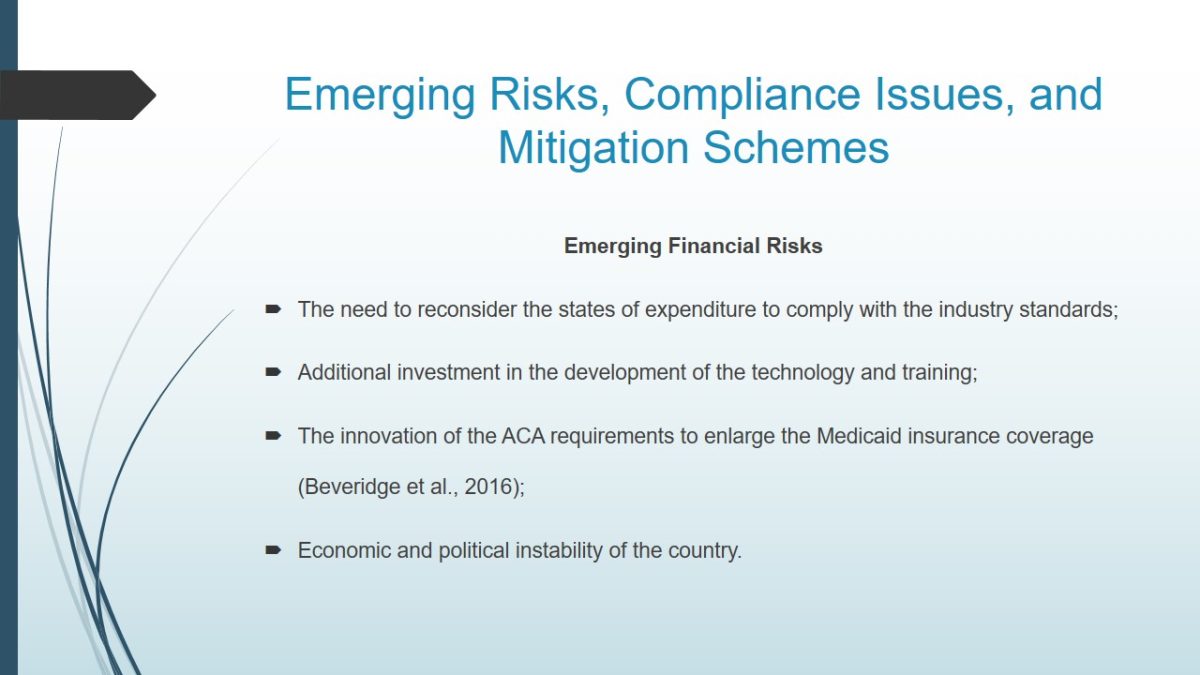
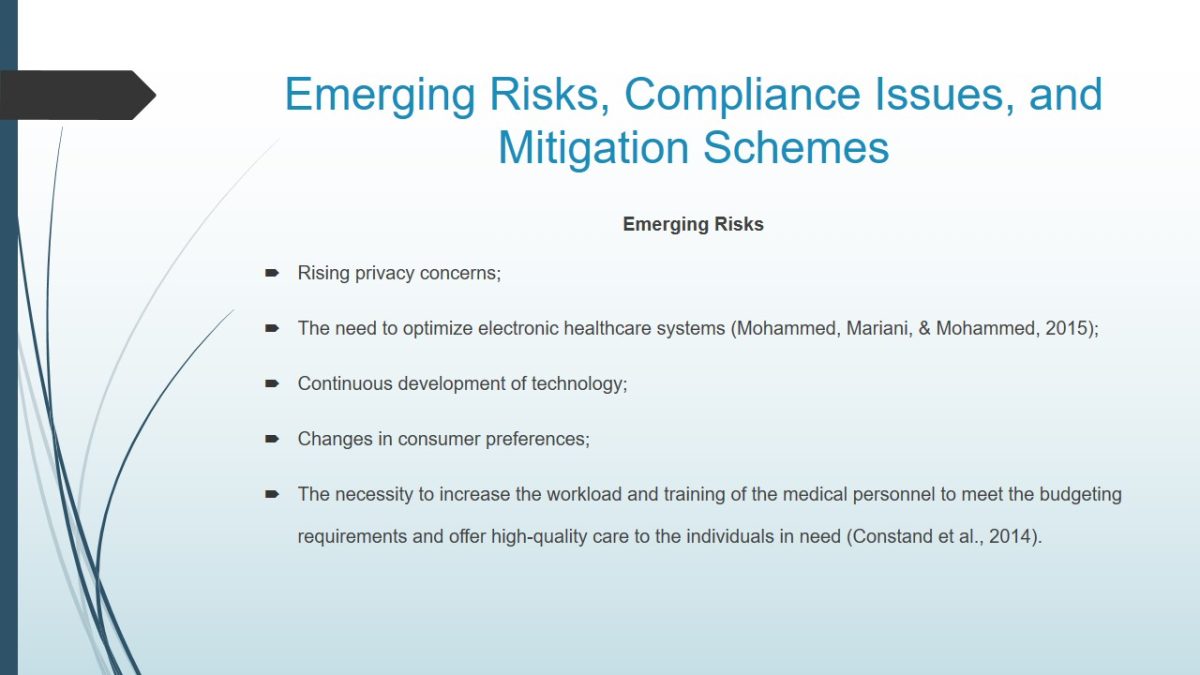
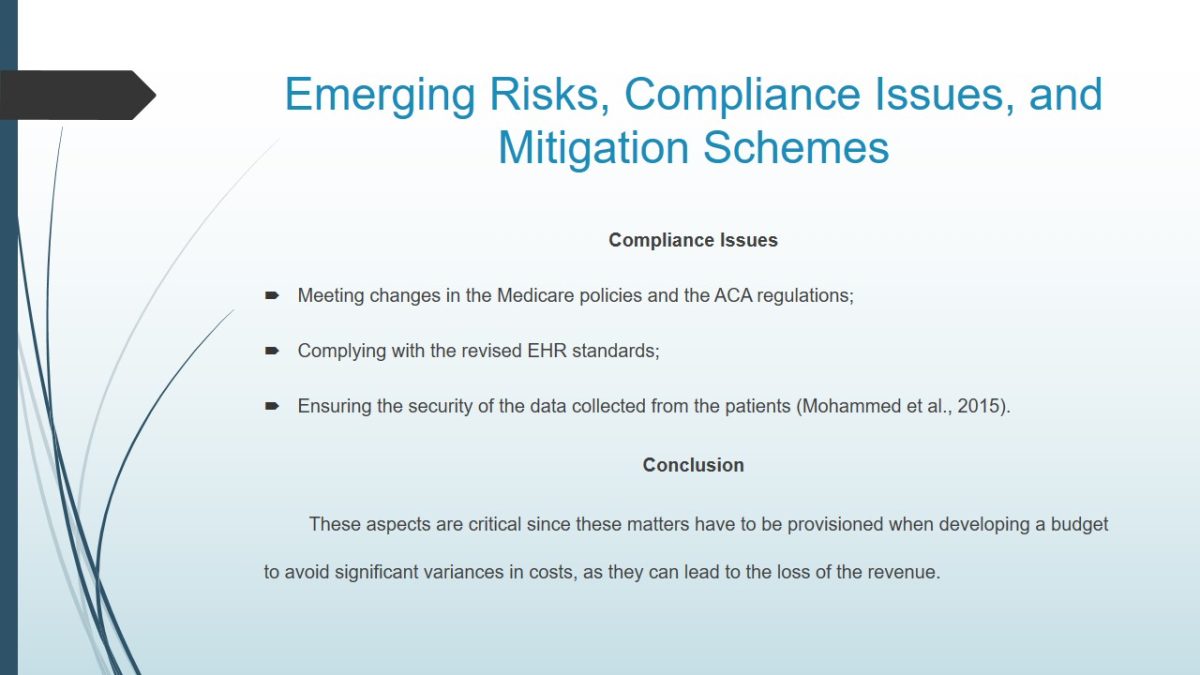

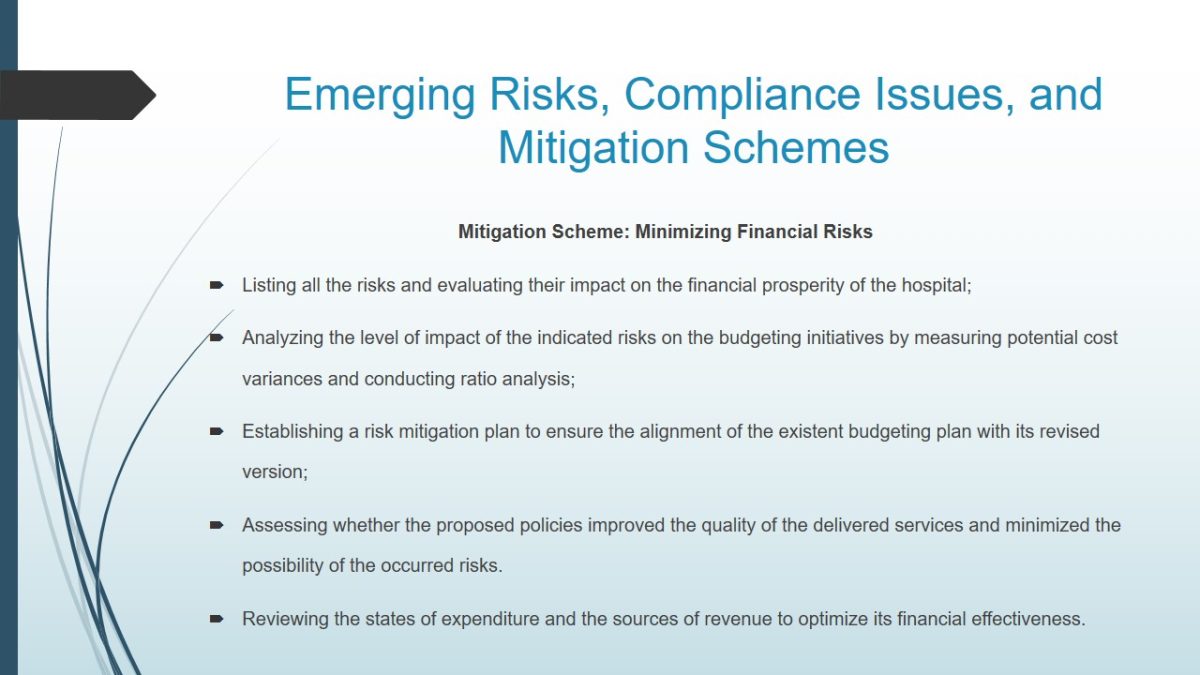
Evolution of Nursing: Leadership and Change Management
Transformational Leadership + Change Management + Evidence-Based Management = Successful Nursing.
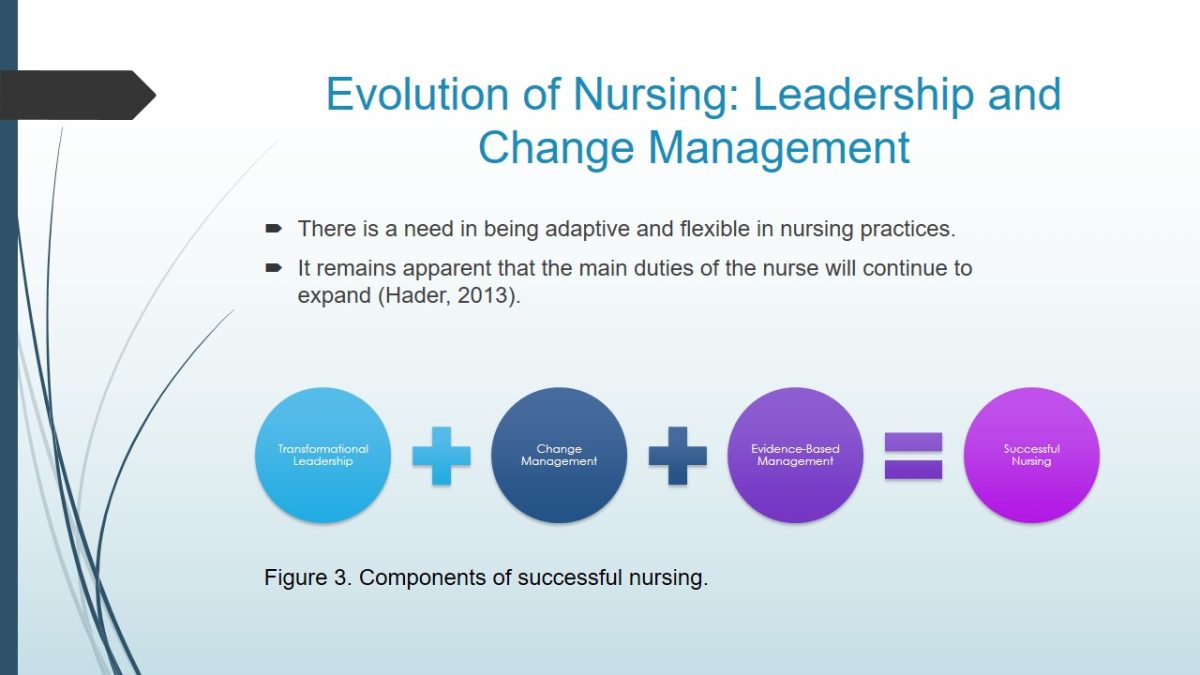
Transformational Leadership
- This approach underlines the importance of change (Hader, 2013).
- It creates a connection between the employees and management (Hader, 2013).
- Nurses can have an impact on decision-making.
- In this case, it gives the nurses an opportunity to make independent decisions and propose suitable innovations.
As for the leadership, it remains apparent that the concept of transformational leadership implies that cultivating change is one of the most important aspects (Hader, 2013). In this case, it increasing the ability of the company to reach its desired outcomes and comply with the altering industry standards successfully (Hader, 2013). At the same time, it depicts that the medical personnel is an important contributor to the decision-making of the organization, and it minimizes an existent gap in power distance (Hader, 2013). In this case, it gives the nurses an opportunity to make independent decisions and propose suitable innovations.
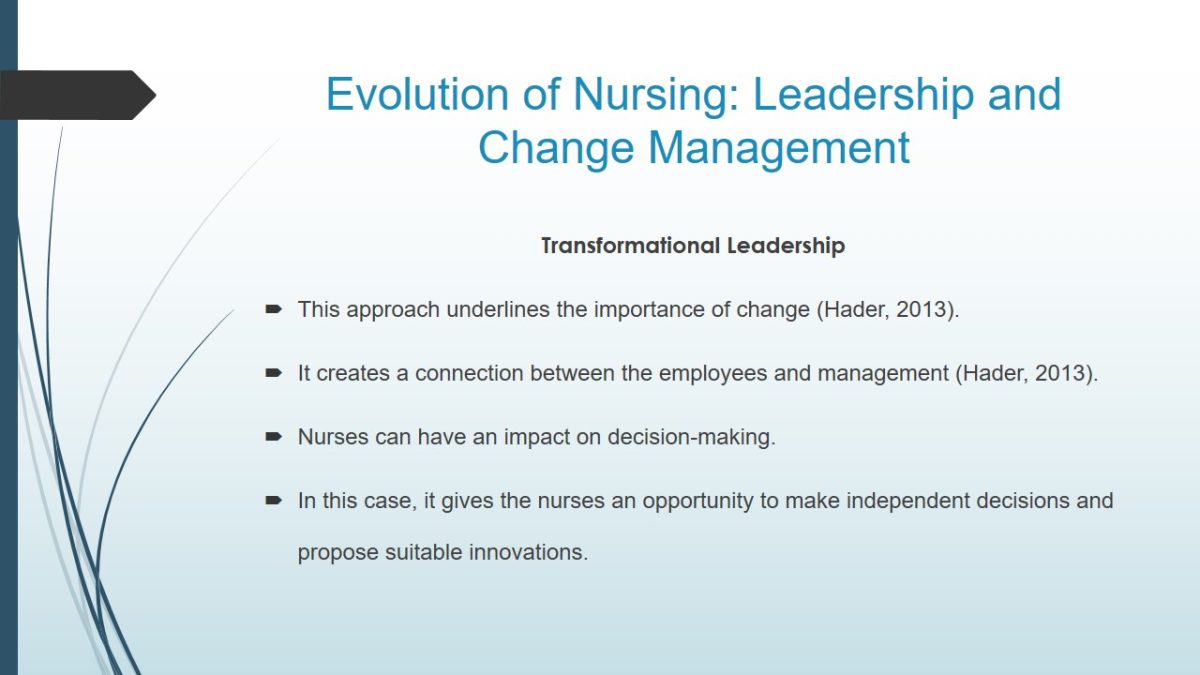
Evidence-Based Management
- This approach ensures that the decisions comply with the current trends and regulations in healthcare (Hader, 2013).
- The decision-making and rational, as it is based on facts and practical experiences.
- Effective budgeting planning and competitive in the market can be discovered as the main outcomes (Hader, 2013).
Another component is evidence-based management. In this instance, the managers have to rely on trends and other facts that can be used as evidence in the industry (Hader, 2013). This strategy will help comply with new policies and maintain competitive in the market. At the same time, it will help optimize healthcare delivery systems and ensure the effectiveness of budgeting initiatives. Overall, it could be said that it offer logical and rational reasons to support a particular decision. The slide presents the main features of the evidence-based management and its benefits.
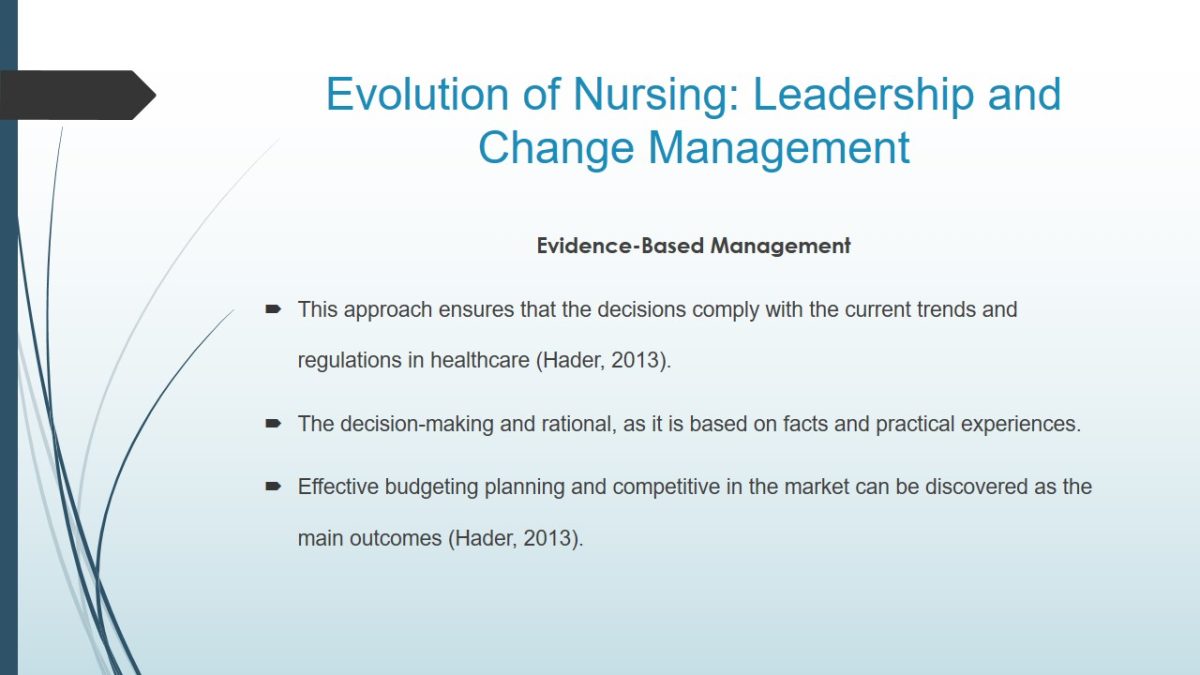
Essential Components of Change Management
- Ensuring the connection with the employees;
- Underlining the significance of trust and identifying its components as the central elements of the corporate culture;
- Emphasizing the gravity of workers in the decision-making process.
Change management is another aspect to be considered. It remains apparent that change is one the central aspects that is critical to the company’s success and financial prosperity (Hader, 2013). In this case, to cultivate change, the managers have to ensure the connection with the employees, underline the significance of trust and identify its components as the central elements of the corporate culture, and emphasize the gravity of workers in the decision-making process. In this case, it could be regarded as a consequence and critical component of transformational leadership.
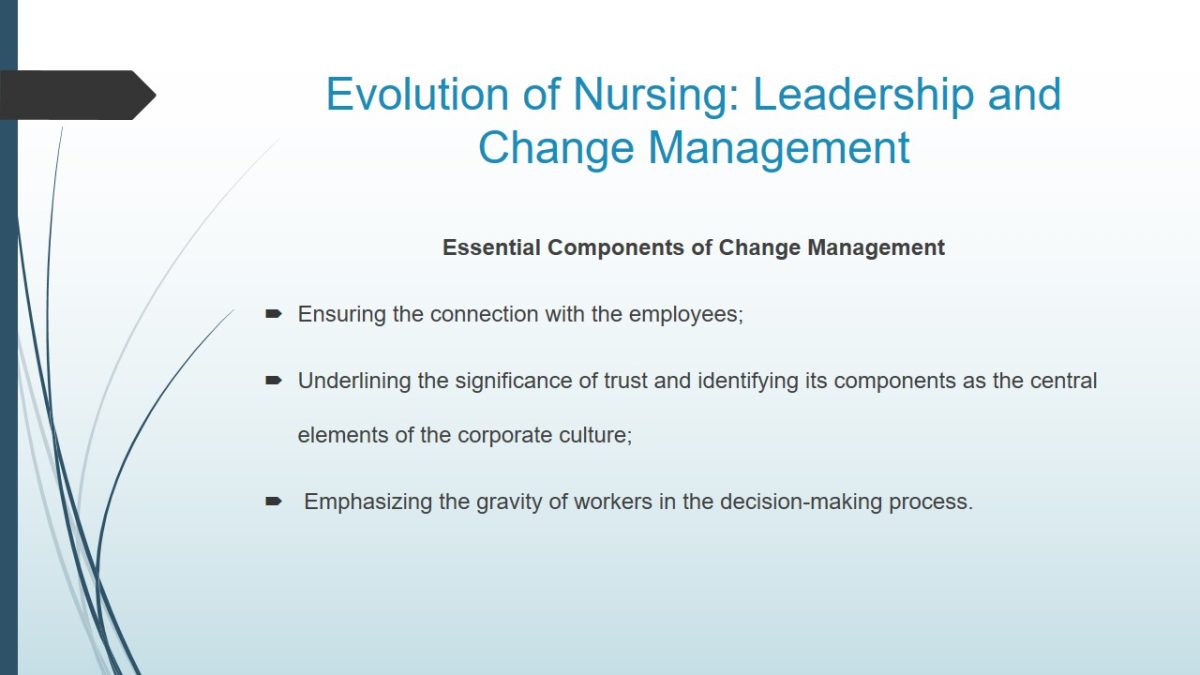
Conclusion
- Financial and compliance issues have a critical impact on the company’s budgeting and decision-making initiatives.
- The main consequences of these changes are the value-based reimbursement systems and patient-centered care.
- Emerging risk are changes in the healthcare legislation and continuous technological improvement.
- The main mitigation strategies pertain to evaluating risks and including the associated expenditures in the budgeting plan.
- As a result, today, nurses can be discovered as innovators and decision-makers.
Financial and compliance issues have a critical impact on the company’s budgeting and decision-making initiatives. In this case, technological improvement, the need for training, and changes in the ACA have to be considered, as they have a critical impact on the development of the budget. At the same time, these matters are the main drivers for the development of value-based reimbursement systems and patient-centered care.
When considering emerging risks, they are referred to the changes in the healthcare legislation and the need to optimize the electronic systems and associated processes. Not ensuring the compliance with the existent guidelines can be regarded as the potential risks due to its negative impact on the company’s expenditure. In this case, the main mitigations strategies pertain to evaluating risks and including the associated expenditures in the budgeting plan.
A combination of these factors change the role of nurses, as now, they have to understand the principles of transformational leadership and evidence-based and change management. Today, nurses can be discovered as innovators and decision-makers.

References
Beveridge, R., Happe, L., & Funk, M. (2016). The physician-insurer dynamic must shift to successfully implement value-based payments. Healthcare, 3(1), 1-15.
Blumenthal, D., Stremikis, K., & Cutler, D. (2013). Healthcare spending – A giant slain or sleeping? The New England Journal of Medicine, 369(26), 2551-2557.
Bowman, S. (2013). Impact of electronic healthcare records on information integrity: Quality and safety implications. Perspectives in Healthcare Information Management, 10(1), 1-14.
Constand, M., MacDermid, J., Bello-Haas, V., & Law, M. (2014). Scoping review of patient-centered care approaches in healthcare. BMC Health Services Research, 14(1), 271.
Hader, R. (2013). The only constant is change. Nursing Management, 44(5), 6.
Mitter, C., & Kraus, S. (2011). Entrepreneurial finance – Issues and evidence, revisited. International Journal of Entrepreneurship and Innovation Management, 14(2), 132-150.
Mohammed, D., Mariani, R., & Mohammed, S. (2015). Cybersecurity challenges and the compliance issues with the U.S. Healthcare sector. International Journal of Business and Social Research, 5(2), 55-66.